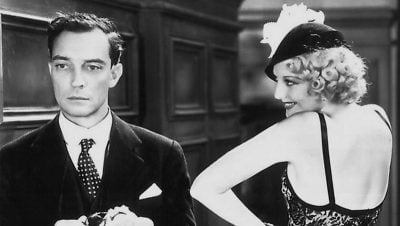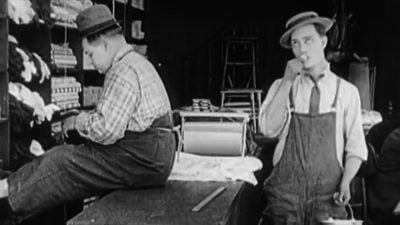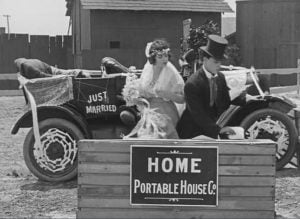
Buster Keaton is a name that rings out amongst film enthusiasts of every age. Thought as one of the (if not THE) greatest actor director in history, Keaton has a story full of the classic hills and valleys of many entertainers trying to make a name for themselves. For Buster Keaton however, he never had the option to pave his own way into entertainment, instead, he was born into it.
Buster Keaton was born Joseph Frank Keaton on October 4, 1895 to vaudeville entertainers, Joseph Hallie and Myra Keaton. The family planted very shallow roots in Piqua, Kansas only because that is the town they were in when Myra went into labor with Joseph. The couple never really had a permeant residence as they were part of a traveling show known as the Keaton Houdini Medicine Show Company. Yeah, THAT Houdini. So, as you can see, Joseph (Buster) Keaton had a path set out before him prior to his birth. It was a path that would lead him to the mountain top of the entertainment industry.
Buster was a nickname that came to Joseph while he was still a baby. When he was just over a year old, he fell down a flight of stairs. A situation where most children would scream out in pain or fear, Joseph simply sat up, shook his head and dusted himself off. A friend of the family, actor George Pardey, laughed at the site and made the statement, “He’s a regular Buster!”
It didn’t take long for Buster to start preforming alongside his mother and father in their shows. When he was three years old, he took the stage for the first time. In the sketch he and his father took middle stage while his mother Myra played the saxophone to set the mood. Buster would comedically disobey his father to the point where his father would start throwing him around the stage. He would crash into the scenery and even at times, be thrown into the audience. A scene that for some would be extremely comedic, was traumatizing for others. A three-year-old boy being tossed around a stage and even thrown into the audience, even back in the late 1800s can raise some issues. Claims of child abuse of course were made and more than a few times, arrests were made. In the end however, Buster was so good at taking these comedic falls, that he never had a broken bone or even a bruise, so the charges never stuck. Due to his ability to take these falls, he was quickly named “The Little Boy Who Can’t Be Damaged.”

It was this early show that one can already begin to see the makings of who would later become the most popular actor in silent film. When the show first started, Buster could not hold back his laughter while his father threw him around the stage. After a while, Buster noticed that his laughing seemed to cause the audience to laugh less. Because of this, he took on the dead pan approach and the audience loved it. Buster would continue this approach all throughout his career.
Buster continued working with his family year-round, with the exception of the summers of 1908-1916 when he would attend the “actors Colony” in Muskegon, MI. Shortly after, in the year 1917, Buster met Fatty Arbuckle. Fatty Arbuckle was an actor and Arbuckle asked Buster to act in a film with him. Unfortunate, Both Buster and his father Joe looked down on the film business at the time. To them, real acting took place in live shows. However, Buster took the role and played in the film The Butcher Boy. He did so well that he was hired on the spot and went on to be in 14 Arbuckle films.
Keaton was a success, and his fame would only continue to grow. He would go on to make the short comedies, One Week (1920), The Playhouse (1921), Cops (1922), and The Electric House (1922) before moving into full length features. It was here that Buster Keaton would live up to his nickname. Buster was known for many things, above all however was his ability to do his own dangerous stunts. Keaton was not always lucky or skillful on these stunts, however. At one point, while filming Sherlock Jr., Keaton broke his neck while preforming a stunt.

It was during this time, 1921 to be exact, that Buster Keaton married his first wife, Natalie Talmadge. Just a year after being married, the couple had their first son, Joseph (James) and two years later their second son Robert was born. Now with a family, Keaton pressed on doing his best to continue his work as THE go to guy in silent film.
During the silent film portion of his life, Keaton retained almost full creative abilities to make his films as he saw fit. Because of this, the films Our Hospitality, The Navigator, Sherlock Jr., Seven Chances, The Cameraman, and The General were all received with great success. However, when sound became a thing in film, Keaton signed a deal with MGM. This severely limited his creative ability and now that he had executives to deal with, his films seriously suffered. Keaton went on to say that signing with MGM was the biggest mistake he ever made.
It was also during this time that his marriage began to suffer tremendously. After their second son, Natalie decided she did not want any more children and cause a rift in Buster and her relationship. They began sleeping in separate rooms and throughout the next few years, Buster would have different girlfriends at different times. In 1932 Natalie divorced Keaton and took with her his sons, and all of his financial earnings. It would be years before Buster was able to see his sons again, not until his oldest was 18.
Struggling to cope with losing his momentum in film, along with losing his entire family and fortune, Buster began drinking heavily and slipped into alcoholism. With his life spiraling out of control, Buster was admitted into an institution where, using tricks he learned from Harry Houdini, he escaped a straight jacket. In 1933 during one of his drunken adventures, Keaton married his then nurse Mae Scriven. Keaton admitted to remembering nothing of the marriage ceremony and it was only two years later the couple was divorced. During this time, Keaton was still working on films and attempting to rebuild his career and fortune to great success luckily.
When Buster stopped his drinking, he met and married Eleanor Norris (1940) and luckily for Keaton, the love that Eleanor gave to him seemed to be the cure he needed to live a more refreshing and fulfilling life. They remained married up until Buster Keaton passed away from lung cancer on February 1, 1966. He was 70 years old and the legacy he left behind, will outlive us all.
Written exclusively for TheLastPicture.Show by Jacob Ruble
Disclosure: The links on this page are “Affiliate Links” and while these are shown at no costs to our viewers, they generate commissions for our website(s)


